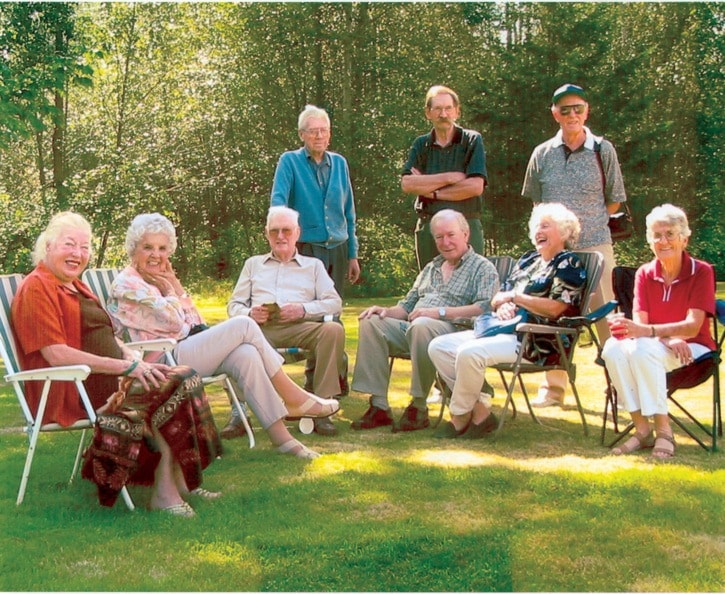It’s pantomime time again, and cause to reflect on the people who started this wonderful annual tradition in White Rock.
Although the leading light, Franklin Johnson, and most of the original members are no longer with us, Guy and Barbara Weston, a couple who joined the Players Club in 1948, recently shared their memories of those early years.
Guy’s family settled in White Rock in 1934, when his parents, Tom and Daisy, bought acreage at Royal and Roper to raise Angora rabbits.
When the market price of wool fell, Tom turned to fruit farming and construction work. Like many other men during the Depression, he took on anything to earn a dollar, including helping out with the local newspaper.
Soon, the family moved to a smaller property on the corner of Centre Street and Royal Avenue, where they kept a goat, chickens and bees.
“We had a lot of vegetables for sale, and mainly raspberries and strawberries which my father used to peddle around town,” Guy recalled.
Guy and his sisters, Jessie and Juana, swam with the White Rock Amateur Swim Association, of which Tom was president in 1937.
After high school, Guy travelled to New Zealand in search of work. He attended teachers college there, and married Barbara, also a teacher, in 1944. Daughter Kay was born the following year.
In 1947, they came to White Rock to meet Guy’s family, intending to return to New Zealand.
“But I got a good (teaching) job,” Guy said. “So we stayed.”
Son Richard was born in 1948.
To get involved in her new community, Barbara was persuaded to attend the reading of a play being put on by the fledgling theatre group.
“I said ‘I won’t go by myself,’ so Guy reluctantly came along. He’d never been on stage before, so it was going to be really interesting. We read, and I ended up with the female lead, and Guy with the male lead.
“Seven or eight couples made up the core of the group. That became our social life, we were in one play after another, and those people were our friends.”
Fortunately they had a built-in babysitter in the form of Guy’s mother.
“I had a wonderful mother-in-law,” Barbara said. “They lived across the lane from us. She knew to the minute when our rehearsals were, and she’d say, ‘Bring the children over,’ or sometimes she would stay overnight. We would never have had such a wonderful time with the Players Club if it hadn’t been for Guy’s mom.”
During the next 25 years, they performed in more than 50 plays.
Their first ‘theatre’ – a vacant storefront – shared a thin wall with the neighbouring café. A hidden door joined the backstage with the café’s phone booth.
“You’d be in a love scene and the phone would ring, and you’d be competing with a drunk explaining to his wife why he couldn’t make it home.”
One year, the pantomine included a dance number with the dancers dressed as parrots.
“Phyllis Clifford and I were in charge of making the costumes. We got two big bags of chicken feathers which we washed by hand. Then we dyed them different colours. I remember saying to Phyllis, ‘How are we going to dry them?’ As I didn’t have a dryer, we decided to go the nearby laundromat, and emptied the bag of coloured feathers into the dryer.
“We realized our mistake as soon as we turned the dryer on. When we turned the dryer off, and opened it, there were feathers everywhere, most of them stuck in those holes. So we had to climb into the dryer, and pull out as many as we could. People going by stared at us in the dryer with all these feathers! We got out as many as we could before going to rehearsal, but we often wondered what the next people to use the dryer thought.
“Anyway, we made the costumes, and they looked quite good.”
Guy’s most embarrassing moment on stage came when he was having a conversation with his leading lady who suddenly forgot her lines and stomped off the stage.
Figuring there was no use staying, he left as well.
“It was the longest third act ever,” Barbara remembered.
In 1975, they retired from the stage, but kept their hand in, ushering until just last year. Their contributions to the club were recognized with lifetime memberships.
An avid sportsman all his life, Guy excelled at swimming, badminton, and sailing. They have owned several vessels over the years.
As Barbara explained, “You get twofootitis when you’re a sailor – always want it two feet bigger.”
On one occasion, in 1972, they set out for Cloverdale with their friends, Hal and Ellen Sinclair, to buy gooseberry plants, and returned home sans gooseberries, but with an 18-foot sailboat.
Guys entire professional life as an elementary school principal was spent in the Surrey district, mainly at Sunnyside, after spending seven years as Ray Shepherd’s first principal. He retired in 1981. Barbara did substitute teaching, and specialized in speech pathology.
Although Guy, at 90, and Barbara, at 88, have lessened their activities, they enjoy an enviable degree of independence. And, by any measure, they have been blessed with a fortunate life.
The Peninsula’s best-known mother-and-son historians, Lorraine and Hugh Ellenwood, are dedicated to preserving history through the White Rock Museum & Archives. Call 604-541-2222, or email whiterockarchives@telus.net
